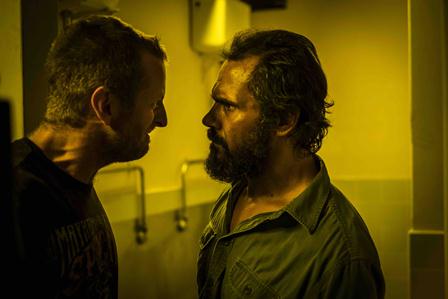Aaron Glenane and Aaron Pedersen.
Stills photographer John Platt used a Fujifilm X-T1 to shoot stills on the set of Killing Ground, the Australian feature debut from shorts filmmaker Damien Power (Hitchhiker) which stars Harriet Dyer, Ian Meadows, Aaron Pederson, Aaron Glenane, Tiarnie Coupland and Maya Stange.
Harriet Dyer.
Platt walked us through his tool-kit:
“In addition to the primary X-T1 I also used a second body, 23mm and 50mm lenses and a 50-140mm zoom lens. The attitude from all on set to the X-T1 was amazingly positive. As each actor arrived on set for the first time I would introduce myself and ask if they would be OK with me shooting during the take, while the camera was rolling. I also made a point of highlighting the camera’s silent shutter. Every one of them agreed they were relieved to know I wouldn’t be asking them to repeat shots just for stills as the Killing Ground storyline is quite confronting and emotionally charged and as such difficult for the actors to recreate for stills.”
The shots make Power's first feature look a cross between Wolf Creek and the Michael Fassbender-vs-delinquent-kids horror Eden Lake from 2008. In Killing Ground, a couple on a camping trip stumble into a frightening ordeal when they discover a tent abandoned in the middle of the bush.
Aaron Glenane.
“On set stills photographers have for many years been able to shoot while the camera is rolling with the use of a blimp to deaden the shutter sound of the SLRs and DSLRs but they never fully silenced it", Platt said.
"In addition to that the blimps are bulky and slow to use. The XT-1 with its compact size and profile allowed me to get into position near the camera without disturbing the actor or their performance and just as importantly DOP/camera operator Simon Chapman ACS and focus puller, Inaki De Ubago."
“For me the experience has been a great way to get to know the camera even better over the combination of day and night shoots. For the days I would have my two zooms attached, 18-55mm and 50-140mm using auto focus with manual exposure. At night I would swap to my primes and in most circumstances have the 23mm and 56mm lenses on and the 35mm in a pouch on my belt ready if needed. My monopod was invaluable at night and at times I pushed the ISO up to 4000. I found the peaking focus assist accurate and invaluable at those wide open stops mixed with constant action, running and fighting.”


